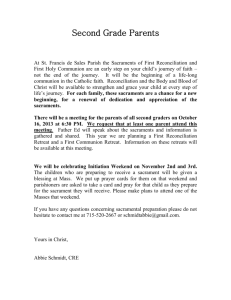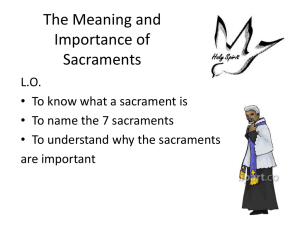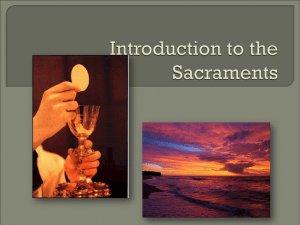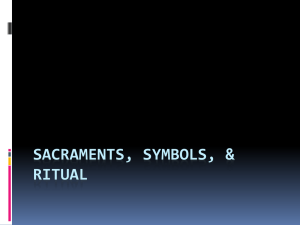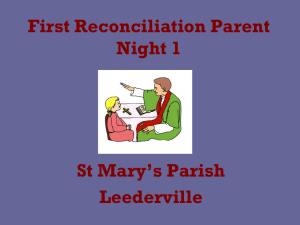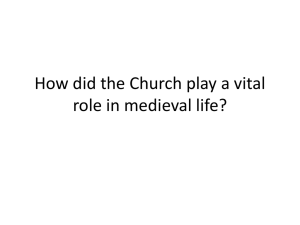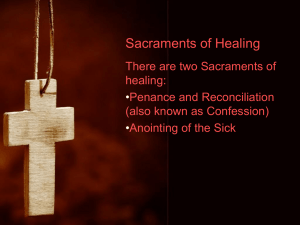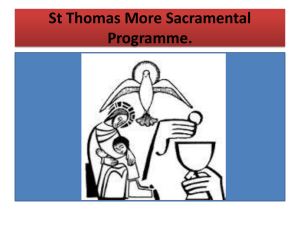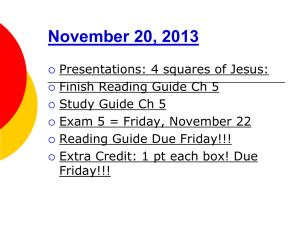Unit 5.7 - We Celebrate the Sacraments Part I
advertisement
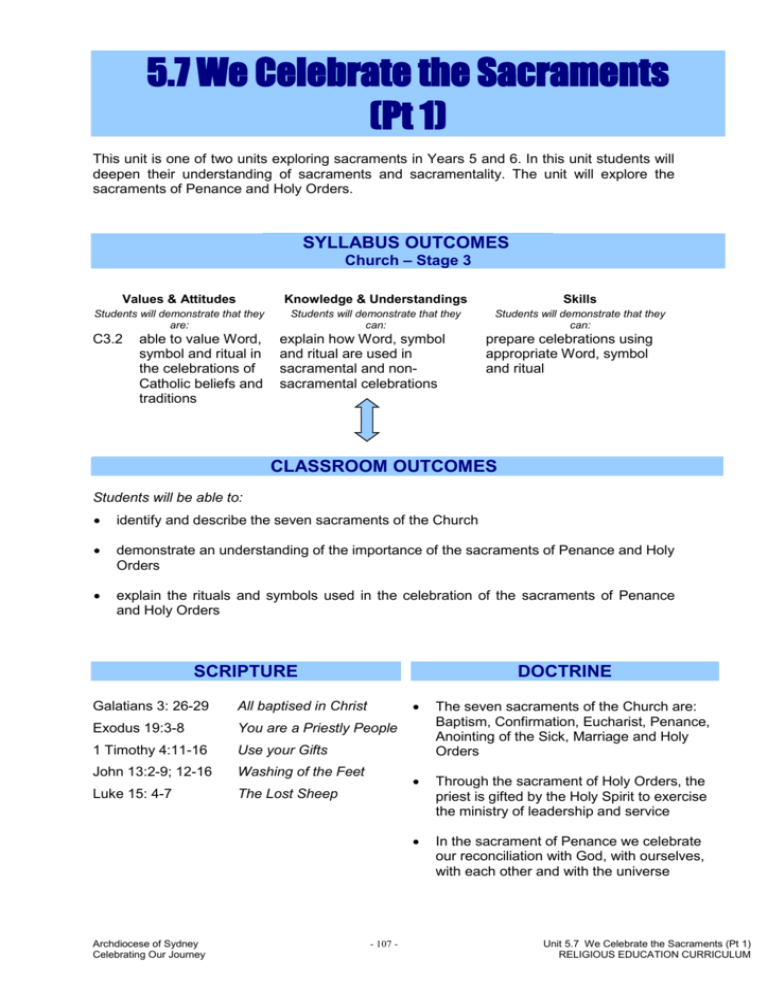
5.7 We Celebrate the Sacraments (Pt 1) This unit is one of two units exploring sacraments in Years 5 and 6. In this unit students will deepen their understanding of sacraments and sacramentality. The unit will explore the sacraments of Penance and Holy Orders. SYLLABUS OUTCOMES Church – Stage 3 Values & Attitudes Knowledge & Understandings Skills Students will demonstrate that they are: Students will demonstrate that they can: Students will demonstrate that they can: C3.2 able to value Word, symbol and ritual in the celebrations of Catholic beliefs and traditions explain how Word, symbol and ritual are used in sacramental and nonsacramental celebrations prepare celebrations using appropriate Word, symbol and ritual CLASSROOM OUTCOMES Students will be able to: identify and describe the seven sacraments of the Church demonstrate an understanding of the importance of the sacraments of Penance and Holy Orders explain the rituals and symbols used in the celebration of the sacraments of Penance and Holy Orders SCRIPTURE DOCTRINE Galatians 3: 26-29 All baptised in Christ Exodus 19:3-8 You are a Priestly People 1 Timothy 4:11-16 Use your Gifts John 13:2-9; 12-16 Washing of the Feet Luke 15: 4-7 The Lost Sheep Archdiocese of Sydney Celebrating Our Journey - 107 - The seven sacraments of the Church are: Baptism, Confirmation, Eucharist, Penance, Anointing of the Sick, Marriage and Holy Orders Through the sacrament of Holy Orders, the priest is gifted by the Holy Spirit to exercise the ministry of leadership and service In the sacrament of Penance we celebrate our reconciliation with God, with ourselves, with each other and with the universe Unit 5.7 We Celebrate the Sacraments (Pt 1) RELIGIOUS EDUCATION CURRICULUM SPIRITUAL REFLECTION FOR TEACHERS The flowers or book that you give on a birthday are a symbol of your love and of your desire for closer union. Every experience and all creation can be a symbol of God's loving presence. So the poet writes: "I see his blood upon the rose, and in the stars, the glory of his eyes..." As the poet declares, Jesus is THE Sacrament – the perfect sign of God's desire for relationship with us. The seven Sacraments are the visible signs of God's presence with us in our journey of faith. In the Sacraments, we ‘touch’ God and God ‘touches’ us. Remember a time when something done for you or a gift given to you made you deeply aware of another's love for you. CATECHISM OF THE CATHOLIC CHURCH Excerpts from the Catechism of the Catholic Church are included below as information for teachers. They present the Church’s teachings contained in this unit. 780 The Church in this world is the sacrament of salvation, the sign and the instrument of the communion of God and men. 1131 The sacraments are efficacious signs of grace, instituted by Christ and entrusted to the Church, by which divine life is dispensed to us. The visible rites by which the sacraments are celebrated signify and make present the graces proper to each sacrament. They bear fruit in those who receive them with the required dispositions. 1210 Christ instituted the sacraments of the new law. There are seven: Baptism, Confirmation (or Chrismation), the Eucharist, Penance, the Anointing of the Sick, Holy Orders and Matrimony. The seven sacraments touch all the stages and all the important moments of Christian life: they give birth and increase, healing and mission to the Christian's life of faith. There is thus a certain resemblance between the stages of natural life and the stages of the spiritual life. 1468 "The whole power of the sacrament of Penance consists in restoring us to God's grace and joining us with him in an intimate friendship." Reconciliation with God is thus the purpose and effect of this sacrament. For those who receive the sacrament of Penance with contrite heart and religious disposition, reconciliation "is usually followed by peace and serenity of conscience with strong spiritual consolation." Indeed the sacrament of Reconciliation with God brings about a true "spiritual resurrection," restoration of the dignity and blessings of the life of the children of God, of which the most precious is friendship with God. 1591 The whole Church is a priestly people. Through Baptism all the faithful share in the priesthood of Christ. This participation is called the "common priesthood of the faithful." Based on this common priesthood and ordered to its service, there exists another participation in the mission of Christ: the ministry conferred by the sacrament of Holy Orders, where the task is to serve in the name and in the person of Christ the Head in the midst of the community. 1592 The ministerial priesthood differs in essence from the common priesthood of the faithful because it confers a sacred power for the service of the faithful. The ordained ministers exercise their service for the People of God by teaching (munus docendi), divine worship (munus liturgicum) and pastoral governance (munus regendi). Archdiocese of Sydney Celebrating Our Journey - 108 - Unit 5.7 We Celebrate the Sacraments (Pt 1) RELIGIOUS EDUCATION CURRICULUM SCRIPTURE: BACKGROUND INFORMATION Galatians 3:26-29 All baptised in Christ Paul is writing to the Christian community in Galatia to remind them of their union in Christ through faith and Baptism. This union means that all barriers are gone – barriers between races and cultures, between slave and free, between male and female – we are all equal and one in Christ as a result of faith and Baptism. It is sad that this is still not a practised reality today. Think of how radical a statement it was in Paul’s time and for hundreds of years after, when slavery was condoned and accepted as normal by all classes of society. What are the challenging ideals we need to encourage today as a result of being baptised Christians? Exodus 19:3-8 You are a Priestly People Chapter 19 of the Book of Exodus is a special and solemn chapter that prepares the way for the giving of the Ten Commandments in Chapter 20. Its ideas and teachings are imbued with important significance. The verses chosen here present a background to the Sacrament of Holy Orders. They describe with poetic imagery God’s choice and care of the people. Significantly they state that the whole nation is priestly and consecrated. We too believe and teach that as a result of our Baptism we also are a priestly and consecrated people. 1 Timothy 4:11-16 Use your Gifts The spiritual ‘gift’ to which Paul refers was given to Timothy through the laying on of hands. This ancient ritual gesture was used to ordain Timothy, an immediate successor of the apostles, and to acknowledge the work of God in him and in his life as a bishop in the early Church. 1 John 13:4-9, 12-15 The Washing of the Feet The challenging and beautiful act of Jesus washing feet that we remember and re-enact on Holy Thursday is only recorded in one of the four Gospels – that of John. In the Gospel of John, the Last Supper focuses on loving service and hospitality and not on the Eucharist. Washing guest’s feet in the Ancient Near East was a sign of welcome and was usually done by servants. But here we see Jesus doing the feet washing as a humble sign of his love and an example for us to follow. The writer of John’s Gospel is using the Last Supper to remind his community of Jesus’ great love and just how much they should love each other. The Gospel of John is very different from the other three Gospels in many aspects but perhaps nowhere more than in the Passion narratives, which begin here in chapter 13 with the washing of the feet. Luke 15: 1-7 The Lost Sheep This is one of three parables - The Lost Sheep, The Lost Coin and The Lost Son in Chapter 15 of Luke’s Gospel, all on the theme of God’s mercy and love, especially in relation to the ‘lost’. In these parables the mercy and love shown the lost even appear as foolishness - a shepherd who leaves ninety-nine sheep to find one, a woman who turns her house upside down for one coin and the Jewish father who welcomes home a son who has asked for and wasted his inheritance. These actions are foolish, but what does this say about the extent of God’s love and care for the lost? 1 KWL, Teaching Companion, 4a, p132 Archdiocese of Sydney Celebrating Our Journey - 109 - Unit 5.7 We Celebrate the Sacraments (Pt 1) RELIGIOUS EDUCATION CURRICULUM THE CHURCH’S TEACHING AND LIVED TRADITION In Tradition: To Know, Worship and Love, Year 5, p53-55 – The Seven Sacraments Catholics believe that God touches our lives, reaching out to us in moments that we rightly term ‘sacred’. The Catholic Church particularly celebrates seven occasions when the sacred presence of God is unmistakable: when we are initiated into the community of believers; when we receive God’s forgiveness and healing; when people commit themselves to lives of service to others and to God. All seven sacraments have their origins in the life and work of Jesus. All sacraments relate to moments in our lives. In the early Church, a sacramental experience was termed ‘mysterion’ or ‘mystery’ in Greek. Later, the Latin term ‘sacramentum’ was used, meaning a kind of sacred pledge, solemn oath or consecration.2 In Tradition: To Know, Worship and Love Year 5, p59-61 – The Sacrament of Penance In the Sacrament of Penance, Christians have always had an opportunity to recognise the need for reconciliation and healing in their lives. This sacrament is the main way our Church celebrates and effects reconciliation with God, ourselves and with other people. Freely offered to us, the sacrament is also our response to God’s generous offer of forgiveness and healing.3 In Tradition: To Know, Worship and Love Year 5, p132-133 – The Sacrament of Holy Orders The Sacrament of Holy Orders is one of the sacraments at the Service of Communion. There are three orders in the sacrament corresponding to the specific vocations of deacon, priest and bishop within our faith community. The bishop, as the chief pastor of the diocese, is shepherd and teacher of the local church. His ministry, together with those of priest, deacon and other pastoral ministries, enables the nurturing and constant growth of the People of God. Both the priesthood of the lay faithful and the ministerial priesthood of those who are ordained are different ways of sharing in the one Priesthood of Jesus Christ. This sacrament speaks of the different tasks to be performed in the Church, as well as the need for the community to have a point of unity. Having their origins within the community, the men who have been ordained are given specific functions to perform in it. They lead and serve our community in worship, give witness to the presence of God through their own lives, and call the community to live its mission faithfully in the world. Those among the faithful who have received Holy Orders are appointed to nourish the Church with the word and grace of God in the name of Christ. (Lumen Gentium, 11)4 2 3 4 KWL, Teaching Companion, 4a, p79 KWL, Teaching Companion, 4a, p87 KWL, Teaching Companion, 4a, p 132 Archdiocese of Sydney Celebrating Our Journey - 110 - Unit 5.7 We Celebrate the Sacraments (Pt 1) RELIGIOUS EDUCATION CURRICULUM CELEBRATION: PRAYER AND LITURGY Celebration is a key part of Religious Education. The following suggestions provide opportunities throughout the unit for celebration in prayer and liturgy. Most of these suggestions are included as ‘teaching/learning’ activities in Unit Content sections. Pray using Gal 3:26-29. Use reflective music, read the text, pray for the different ‘groups’ in your community and ask God for the gift of unity. Choose appropriate symbols and rituals to use. Plan and celebrate a Liturgy of the Word to celebrate the work of your priest, other clergy and all those who minister in the Church in various ways. Celebrate a liturgy of the Word. Celebrate a liturgy of the Word as a non-sacramental rite of penance. (See Appendix II, Rites of Penance, for examples.) Read the parable of the Lost Sheep. Use KWL Year 5, p63 as an examination of conscience. Play reflective music and ask the students to respond to the questions silently. Students think of 3 ways they have faithfully followed Jesus (grace) and 3 ways they have not (sin). Class recites a prayer of sorrow (Act of Contrition) and sings a song of thanksgiving. Remember to respect the students’ privacy when using an ‘examination of conscience’. It is carried out internally. Link the celebration to an event where possible, eg after a class fight or dispute, or studies in other KLAs. Students plan and celebrate the Sacrament of Penance (the Second Rite of Reconciliation). (The planning could be used as assessment.) Invite parents to the celebration. Students prepare and participate in penitential celebrations. Use appropriate word, symbol and ritual (Worksheet 3) – prepared in groups. Archdiocese of Sydney Celebrating Our Journey - 111 - Unit 5.7 We Celebrate the Sacraments (Pt 1) RELIGIOUS EDUCATION CURRICULUM ASSESSMENT Interim Assessment Statement 2014 The identification of Teaching/Learning strategies as ‘suggested assessment’ has been removed from the 3-6 RE curriculum. The type of assessment activity and the way evidence of learning is gathered will vary, depending on such factors as; the outcomes being assessed, the evidence being gathered, the teaching and learning activity, context and students’ learning needs (NSW Board of Studies, http://syllabus.bos.nsw.edu.au/supportmaterials/k-6-assessment-strategies/) . Assessment in Religious Education is based on the same principles as in other key learning areas. Please refer to the CEO Sydney site supporting the implementation of the Australian Curriculum in the context of the NSW BOS Syllabus. At this site https://sites.google.com/a/syd.catholic.edu.au/professional-learning-modules/home professional learning modules are provided to support teachers as they engage with the NSW BOS Syllabuses for the Australian Curriculum. Module 4, Assessment and Planning explores the principles of effective assessment for, as and of learning and considers a range of strategies and methods for assessing student learning. Activities focus on moving beyond assessment as an index of learning, towards assessment that motivates, enhances learning and achieves deeper understanding to meet the diverse learning needs of all as students. Participants are encouraged to reflect on assessment as a driver for improvement in teaching and learning. Religious Education Curriculum and Assessment In Year 3-6 Religious Education Curriculum, both Syllabus Outcomes and Classroom Outcomes are key reference points for decisions about students’ progress and achievement. Classroom outcomes are more specific to the unit content. Unit Content statement and Students will learn statements in each unit should also be taken into account in planning and developing learning and assessment opportunities. Outcomes and Unit Content Statements are derived from Syllabus objectives. Effective Religious Education involves teaching the Catholic faith (Scripture, doctrine, traditions, prayer and sacraments) and nurturing the faith of the child. There is no attempt to assess the child’s faith. Assessment is concerned with skills, knowledge and understanding of the Catholic faith taught in the curriculum and supported in the religious life of the school. RESOURCES To Know Worship and Love, Year 5, Chapters 4, 5 and 13, (2003), James Goold House Publications, Melbourne, Victoria Books The Rites, Vol 1 and 2, (1990), Pueblo Publishing Company, NY Ryan M, (1999), Sacraments of Healing, Social Science Press, Australia Woods L, (1999), A Dictionary For Catholics, HarperCollins, Victoria Websites http://www.catholicozvocations.org.au/index.php http://www.catholicvocation.org.au/index.html (National vocations) (Diocese of Melbourne) KEY TO SYMBOL denotes higher order activity Archdiocese of Sydney Celebrating Our Journey - 112 - Unit 5.7 We Celebrate the Sacraments (Pt 1) RELIGIOUS EDUCATION CURRICULUM Archdiocese of Sydney Celebrating Our Journey - 113 - Unit 5.7 We Celebrate the Sacraments (Pt 1) RELIGIOUS EDUCATION CURRICULUM UNIT CONTENT 1 Sacraments are signs of the activity and presence of God. Students will learn: to define the word ‘sacrament’ about the seven sacraments and their purpose about the symbols and rituals of the seven sacraments UNIT CONTENT: BACKGROUND INFORMATION Symbols speak to our imagination, our senses, our emotions, in fact to the whole person. Life is full of symbols and rituals. We use them for a wide range of experiences from the ordinary to the special events in our lives. In greeting each other we shake hands, kiss, hug. We may have particular ways of doing things. All around us are objects that hold rich personal meaning for us. Symbols and rituals are all around us; often they are taken for granted. Symbols have unlimited meaning and can carry different interpretations simultaneously. Some symbols reach the imagination of a community, which has a shared understanding and shared meaning. Sacraments are visible signs of the presence of God. They are an encounter with God. Sacraments are moments of God’s self-communication and occur throughout human life. They capture our imagination and reveal to us something of God. People can be sacraments to one another. Creation can be a sacrament, communicating the presence of the creator God. These are referred to as sacramental moments or experiences. They inspire awe and wonder in the awareness of the presence of God. Jesus is the original and central sacrament. He is the revelation of God par excellence. The Church, the body of Christ, is also a sacrament. Hence sacraments are visible signs of the incarnate God and the God of salvation (the Paschal Mystery). The life of the Church reveals the saving and transformative presence of God. The Church defines seven ecclesial actions that are sacraments in its liturgical life. These sacraments of the Church are distinctive and transformative events in the community and the individual person. These seven sacraments of the Church are grouped into 3 categories: Initiation: Healing: Baptism Confirmation Eucharist: Reconciliation Anointing of the Sick At the service of communion: Marriage Holy Orders Note that the sacraments of Marriage and Holy Orders are no longer referred to as the Sacraments of Vocation. All Christians are called to a vocation through the sacraments of initiation. Marriage and Holy Orders are sacraments ‘at the service of communion’ or ‘in the service of community’. The two names are interchangeable. The Church is the body of Christ. Both sacraments build up the body of Christ. This Unit covers the definition of sacraments and the sacraments of Holy Orders and Penance. The sacraments of Marriage and Anointing of the Sick are covered in the Year 6 ‘sacrament’ unit (6.7). The sacraments of Initiation are covered in separate units (6.4, 3.7). This Unit Content explores symbols and rituals in everyday life and within the seven sacraments of the Church. Students need to explore a definition for sacraments. Reflection on life experience can reveal sacramental moments in each person’s life. Draw these together in an overview of the seven sacraments of the Church. Archdiocese of Sydney Celebrating Our Journey - 114 - Unit 5.7 We Celebrate the Sacraments (Pt 1) RELIGIOUS EDUCATION CURRICULUM SUGGESTED TEACHING/LEARNING STRATEGIES Symbols and Rituals Gather examples of symbols. Discuss and record their attributes. Define ‘symbols’ and make clear the distinction between symbols and signs. Use Resource Sheet 1 to explore symbols in everyday life and in Church celebrations. Students work in small groups to list examples and explain their use in everyday life or in the sacraments. Research the meaning of the term ‘ritual’. Discuss examples of rituals in students’ families, community, and school. Use Resource Sheet 2 to explore rituals. Students work in small groups to list examples of rituals and explain their use in everyday life or in the sacraments. Either organise and celebrate a class Mass or ask the students to be attentive to ritual actions during the Sunday Mass. Students demonstrate any ritual gestures they observe during the Mass. List and illustrate the ritual gestures and state what these gestures might mean. Invite the parish priest or pastoral associate to speak to the students about ritual gestures in the Mass and sacraments in general. Sacramental Moments/Experiences Discuss experiences of wonder and awe. - Paint, illustrate or write about a place or experience that has filled you with wonder and awe. - Describe how you felt in the place or experience. Some people describe these sorts of experiences as ‘being aware of God’s presence’. Discuss why this might be the case. Explain that the awareness of the presence of God is a prayer in itself. Define ‘sacrament’. Students list times in their life that were sacramental moments. Discuss Jesus and Church as sacraments, signs of God’s presence. Galatians 3:26-29. - Locate Galatia on a map of biblical times. - Read the text. Discuss unfamiliar words and concepts (gentile, union …) Who is speaking/writing? - What are some possible reasons Paul wrote this text? What may the community have been experiencing? (The community may have been divided.) How would the different people in the community have felt after reading Paul’s message: slave, free person, woman, man, gentile, Jew? - What implication does this have for our community? Imagine you have just received this letter from Paul. What is your response? - Use movement or art to communicate the concept of union. - List 3 different ‘groups’ in your community. Pray using this Scripture text. Use reflective music, read the text, pray for the different ‘groups’ in your community and ask God for the gift of unity. Choose appropriate symbols and rituals to use. Church Sacraments Read KWL Year 5, p53-54. List and define significant words. Explore their meaning, e.g. community, extraordinary, grace, gestures. Read KWL Year 5, p54-55. List the seven sacraments of the Catholic Church. Discuss and define the categories: initiation, healing, at the service of communion. Introduce doctrine on the seven sacraments. Create a matrix to organise information about the sacraments. Archdiocese of Sydney Celebrating Our Journey - 115 - Unit 5.7 We Celebrate the Sacraments (Pt 1) RELIGIOUS EDUCATION CURRICULUM Sacrament Symbols Used Rituals Used Purpose/Description Reception of the sacrament Students make a card set for the seven Sacraments. Students will need fourteen cards. On seven of the cards list the names of the Sacraments. On the other seven, in their own words, students write an accurate description of each Sacrament. Play a ‘matching’ game with a partner, matching the Sacrament with its correct description. Create a family inventory of Sacraments celebrated, including names, dates, places and memories. Students name the sacraments of initiation, healing, at the service of communion. Write a brief explanation of the purpose of each sacrament. or Fill in an incomplete matrix of the sacraments and their purpose. or Students match the sacraments with a brief explanation of their purpose and group them. Complete a grid to summarise the information. Fill in parts of the grid and allow students to fill in the rest of the grid. (This task could be done at the end of the unit with emphasis on Holy Orders and Penance.) Sacrament Symbols and Rituals Meaning Importance Baptism Confirmation Penance Holy Orders Archdiocese of Sydney Celebrating Our Journey - 116 - Unit 5.7 We Celebrate the Sacraments (Pt 1) RELIGIOUS EDUCATION CURRICULUM UNIT CONTENT 2 The Catholic Church celebrates Holy Orders as a sacrament at the service of communion. Students will learn: about the role of the bishop, priest and deacon about the symbols and rituals of the sacrament of Holy Orders about the significance of the sacrament of Holy Orders in the life of the Church UNIT CONTENT: BACKGROUND INFORMATION This Unit Content focuses on the Sacrament of Holy Orders. There are 3 orders within this sacrament: the order of episcopate (bishops), the order of presbyterate (priests), and the order of deaconate (deacons). In exploring the symbols and rituals of the sacrament it is important to cover all three orders. Explore the rituals and symbols of ordination to the episcopate, presbyterate and deaconate, and the roles of each distinct office. The Sacrament of Holy Orders complements the priesthood of all people through Baptism. The candidate becomes an ordained priest for the priesthood of the faithful. By virtue of his ordination the priest has a unique and distinctive presence in the Church. The ordained priest is the leader of the community. In the Christian understanding ‘leader’ carries the connotation of service. The leader serves the community. The priest is the leader of the parish community. He is the symbol of the community’s unity. In the same way, the bishop is the leader and symbol of unity of the Church in the diocese. The ministry of the bishop, priest and deacon enables the members of the community to take up their mission within the community, as baptised members of the Church. As such, the ordained minister is not the sole worker in the parish. He works with the community of baptised. As the leader and symbol of unity, the ordained ministers empower the priesthood of the people to continue the mission of Jesus. SUGGESTED TEACHING/LEARNING STRATEGIES What can you find out about the following? - Who is our Archbishop or Bishop? Our auxiliary (assistant) Bishop/s? What is the name of our diocese? Our cathedral? Who is our Parish Priest (priests of our parishes)? What is the name of our parish (or parishes)? Do you have a deacon in the parish? What is his name/role? Brainstorm what you think a priest does. Interview your parish priest and/or a deacon about his ordination and work at present. The following suggested questions are adapted from the website on vocations in Melbourne; see the resource list. - Who do you talk to when you have a problem? - What other jobs/roles do priests have other than Parish? - What's not so good/not so cool about being a priest? - Is there anything about our faith that you find difficult to understand/explain? - Why did you choose to become a priest? - How long does it take to become a priest? - Can you stop being a priest? - What's good/cool about being a priest? - Who were your role models? - Do you ever find it difficult to pray? Archdiocese of Sydney Celebrating Our Journey - 117 - Unit 5.7 We Celebrate the Sacraments (Pt 1) RELIGIOUS EDUCATION CURRICULUM Exodus 19:3-8 - Students recall their knowledge about Moses and the Israelites in the desert. - Use the ‘Scripture: Background Information’ to prepare students to hear this passage. - Read the Scripture text to the students. Who are the characters? Where does the story take place? What is happening? What is the ‘new covenant’ mentioned? Who will serve God as ‘priests’? - God tells Moses that the people will serve God as “priests”. What does this mean? Lead the students to understand that God calls all of Israel to be a ‘priestly people’. By our Baptism we are also a ‘priestly people’. Survey a variety of parish groups. Find out details of their work and the ways in which your parish priest (and deacon) support this work. Draw a table to display the different roles/tasks that your parish priest, local bishop and deacon perform in the course of their work. Categorise tasks as administrative, pastoral, liturgical or educational. Add other categories you feel are appropriate. Who participates with these ministers in their work? 1 Timothy 4:11-16 - Give students a brief background to this Scripture passage. Who was Timothy? Who is writing the letter? Why do people write letters? Why may Paul be writing this letter to Timothy? - Read the Scripture text. - What is Paul telling Timothy? In Paul’s view, how can Timothy be an example for believers? List these and briefly brainstorm ideas for each. For example we can be a good example for others in the way we speak: using kind words, being polite, telling the truth with kindness… - What rituals or symbols were used to demonstrate that Timothy had spiritual gifts given to him? (Laying on of hands by elders) - Explain that Timothy preached the Good News and was a ‘leader’ in the church. What does this Scripture text say about priests? (As a successor to the apostles Timothy was a bishop. The early Church, in the New Testament, did not use the language we use today to refer to the ordained ministry.) Use PowerPoint presentation (provided with this unit in ‘Related Files’) to explore the Ordination ceremony for a priest and the Rite of Ordination. You may wish to use this ppt as an overview and then return to different parts of it, or you may prefer to use parts of it over a number of days. See also KWL Yr 5, p132-133 ‘In Tradition’. Draw a diagram emphasising the important features of an ordination ceremony (include the symbols, gestures and prayers used during this ceremony). List and explain significant symbols and rituals used in the sacrament of Ordination. Include these on the matrix. What is the purpose of Holy Orders? John 13:2–9, 12–15 Washing of the Feet Tell the Story - Washing of the Feet using suggested script, Resource Sheet 3, and visuals K.2B. Note: visuals are the same as Kinder, but text is changed to suit the age level. Engage students in wondering. See suggested wondering below. - I wonder why Peter refused to let Jesus wash his feet. I wonder why he changed his mind and said “Lord, not only my feet but also my hands and my head!” I wonder what Jesus wanted to teach his disciples by washing their feet. I wonder what we can do to follow Jesus’ example. I wonder why this is a special reading for deacons, priests and bishops. Introduce doctrine about Holy Orders. Read the descriptions of the orders of bishop, priest and deacon in KWL Year 5, p127-130. Decide upon the important characteristics a Archdiocese of Sydney Celebrating Our Journey - 118 - Unit 5.7 We Celebrate the Sacraments (Pt 1) RELIGIOUS EDUCATION CURRICULUM person would need to fulfil each of these roles. Discuss the role of bishops, priests, deacons in the diocese and parish. Devise a “personal profile” for each of them. Investigate the ‘new’ role of permanent deacons in the Catholic Church. Who can be a permanent deacon? What does a permanent deacon do in the Church? What is the difference between a permanent and temporary deacon? Plan and celebrate a Liturgy of the Word to celebrate the work of your priest, other clergy and all those who minister in the Church in various ways. Read about Australia’s first bishop in KWL Year 5, p134. Students complete a brief information report on Bishop Polding. - Research the life and work of a famous priest (eg your parish priest, the diocesan bishop, Blessed Damien of Molokai, Archbishop Oscar Romero, Father John Therry...). Write a short information report about this person. Briefly describe the Sacrament of Holy Orders and its importance in the life of the Church. Include some of the major symbols and rituals used. Students may do this through a written explanation, a short assignment or presentation using ICT. Archdiocese of Sydney Celebrating Our Journey - 119 - Unit 5.7 We Celebrate the Sacraments (Pt 1) RELIGIOUS EDUCATION CURRICULUM UNIT CONTENT 3 The Catholic Church celebrates Penance as a sacrament of healing. Students will learn: about the significance of the sacrament of Penance in the life of the Church about the symbols and rituals of the sacrament of Penance about the three rites of the sacrament of Penance UNIT CONTENT: BACKGROUND INFORMATION This section covers the sacrament of Penance. Students need to continue looking at symbols and rituals of the sacrament, review the three rites and deepen their understanding of the concepts of sin and forgiveness. Traditionally, there are a number of ways people seek and experience forgiveness in the Church. The sacrament of Baptism forgives sins. Thereafter, a person seeking conversion can experience forgiveness for venial sin in the celebration of the Eucharist and receiving Holy Communion, through acts of mercy and charity, fasting and prayer. For example, in the Our Father we pray, “Forgive us our sins as we forgive those who sin against us.” These ways of experiencing the forgiveness of God do not take away from the importance of the Sacrament of Penance. The Catholic tradition has always taught that a human being is both graced and fallen. Grace is a gift of God. Human beings are graced with a tendency to move towards God. ‘Fallen’ refers to the human being’s capacity to sin or choose to move away from God. ‘Sin’ is the term used to describe situations that erode or destroy our relationship. We all experience these situations of sin. We are called to live life and live it to the full. Living life to the full needs right relationship with self, others, God and all creation. There are decisions we make that enhance life and those that diminish life. There are also experiences of healing and reconciliation. Traditionally we have two categories of sin: 1. Venial sin, an experience of everyday sin, is the most common form of sin. 2. Mortal sin, a more serious wrong which is ‘life denying’. All sin is serious as it damages our relationship with God, others and self. In exploring sin we need to also explore grace, freedom, choices and relationships. Non-sacramental penitential celebrations, as set out in Rites of Penance (appendix II), can help us express our need for forgiveness and conversion and our belief in a forgiving God. There are three rites of Reconciliation (ways we celebrate the sacrament of Penance). - First Rite of Reconciliation. This is an individual experience. The penitent receives the sacrament privately with the priest. - Second Rite of Reconciliation. This is experienced as a community. We gather as a community and celebrate the liturgy. We seek individual confession and absolution. This is the most common rite we celebrate in schools. - Third Rite of Reconciliation. This is a community experience with communal absolution. It is rarely used. In all the rites the priest leads the sacramental celebration and symbolises God and the community. The Sacrament of Penance has its greatest meaning within the framework of our covenant relationship with God. The sacrament reminds us of something that already is: we are forgiven by God who is always loving and forgiving. The sacrament also actualises the forgiveness of God and reconciliation between God and the person/people. Archdiocese of Sydney Celebrating Our Journey - 120 - Unit 5.7 We Celebrate the Sacraments (Pt 1) RELIGIOUS EDUCATION CURRICULUM SUGGESTED TEACHING/LEARNING STRATEGIES Read and discuss KWL Year 5, p57-58. Create a word bank of key words. Discuss the meaning of these words. - Discuss: What is sin? Discuss the term ‘mortal sin’. Some sins are more serious than others. Explore the notion of sin. Connect sin with choices and decisions we make. - Define ‘reconciliation’, ‘penance’ and ‘confession’. Brainstorm words that show what we mean by ‘reconciliation’. Role-play life situations which demonstrate experiences of sin (breaking down relationships) and reconciliation. Tell the Story - The Lost Sheep (Lk 15:1-7) using 2D materials on RE Online and suggested script - Resource Sheet 4. Engage students in wondering - I wonder if you have ever lost something that is precious to you. I wonder how you felt after you have found it again. I wonder what Jesus was wanted to teach the people by telling this parable. I wonder who the lost sheep in the story could really be. I wonder how we can be ‘lost’. I wonder how we can be ‘found’. Luke 15:1-7 - Discuss the image of sheep and shepherd. What is the relationship between a shepherd and sheep? - Read the parable from KWL Year 5, p59 or the Bible, (note: KWL begins at v4 not v1). - Explore the four parts of the parable. Lost (v4a) Search (v4b) Found (v5-6a) Celebrate (v6b). - Get students to relate this back to God, who seeks the lost and brings the lost back into relationship and community. - Students write a journal about one experience of lost and found. This could be an experience of losing a possession or a relationship due to a dispute or conflict. Read KWL Year 5, p62-63 ‘Living the Gospel’. Explain the ‘examination of conscience’. Celebrate a non-sacramental Penitential celebration. (See Rite of Penance – Appendix II in The Rites Volume 1, for examples.) Read the parable of the Lost Sheep. Use KWL Year 5, p63 as an ‘examination of conscience’. Play reflective music and ask the students to respond to the questions silently. Students think of three ways they have faithfully followed Jesus (grace) and three ways they have not (sin). Class recites a prayer of sorrow (Act of Contrition) and sings a song of thanksgiving. Remember to respect the students’ privacy when using an ‘examination of conscience’. It is carried out internally. Link the celebration to an event, where possible. For example, after a class fight or dispute, or studies in other KLAs. Students work in small groups to prepare and participate in a class prayer on the theme of reconciliation, using appropriate Word, symbol and ritual. Use a planning sheet to outline the celebration and the use of symbols and rituals - see Resource Sheet 5. - Design a collage, using pictures depicting social justice issues and write about your feelings relating to these issues. Discuss how reconciliation might happen in relation to the images represented. List the meanings of these words: penance, contrition, conversion, confession, pardon, forgiveness, acceptance and repentance. Make a crossword puzzle listing the meanings as clues. Tell the Story of The Sacrament of Penance - 2nd Rite of Reconciliation using suggested script - Resource Sheet 6 and Posters provided with this unit on RE Online. You will need to print and laminate posters. Archdiocese of Sydney Celebrating Our Journey - 121 - Unit 5.7 We Celebrate the Sacraments (Pt 1) RELIGIOUS EDUCATION CURRICULUM Engage students in wondering -see suggested wondering below. - I wonder what part you like the best. I wonder what it feels like for you - to receive God’s forgiveness and healing. I wonder how you know when you need reconciliation and healing in your life. I wonder how you feel after reconciliation. I wonder why this sacrament can be received again and again. Read KWL Year 5, p59-61 ‘In Tradition’. Discuss the structure of the sacrament of Penance - 1st Rite of Reconciliation and the importance of each aspect. Introduce the doctrine on Penance. Examine the three rites of reconciliation. See KWL Year 5, p64. Explain each rite, its structure, symbolism, rituals and meanings. Why are there three rites? What does each rite tell us about reconciliation? Students briefly describe the importance of the Sacrament of Penance in the life of the Church. Students could present a powerpoint presentation explaining ways we seek forgiveness, the symbols and rituals acts used in the sacrament and how it is a sacrament of healing. Compose a simple prayer of sorrow to God. Students plan and celebrate the Sacrament of Penance (the Second Rite of Reconciliation). Invite parents to the celebration. Archdiocese of Sydney Celebrating Our Journey - 122 - Unit 5.7 We Celebrate the Sacraments (Pt 1) RELIGIOUS EDUCATION CURRICULUM Resource Sheet 1 Below are some interesting ideas about symbols. In pairs or groups, record examples from your own experiences: Symbols have different meanings… Symbols can have powerful meanings… Some symbols have meaning for a nation, or even the world… Symbols can cause us to experience deep feelings… (KWL, Teaching Companion, 4a, p82) Archdiocese of Sydney Celebrating Our Journey - 123 - Unit 5.7 We Celebrate the Sacraments (Pt 1) RELIGIOUS EDUCATION CURRICULUM Resource Sheet 2 EXPLORING RITUALS Rituals are important in our lives. They involve actions, words and symbols, all working together. Complete the table with features of different rituals. Rituals have movements and gestures Ritual actions are often repeated Rituals help us to remember and to celebrate important events Rituals use important words Rituals happen in community Rituals need people to be interested and to take part (KWL, Teaching Companion 4a, p83) Archdiocese of Sydney Celebrating Our Journey - 124 - Unit 5.7 We Celebrate the Sacraments (Pt 1) RELIGIOUS EDUCATION CURRICULUM Resource Sheet 3 THE WASHING OF THE FEET (John 13:2–9, 12–15) KWL Year 5 p131 YOU WILL NEED: Length of white ribbon to use as a story timeline. Visual Set: K.2B ‘Washing of the Feet’ (note: whilst visuals are the same as K, the script is different. This is also available on CD ‘K-1 Religious Education Visual Sets’ (available from CEO, Sydney). 1. Jesus takes bowl and towel 2. Jesus pours water into a bowl 3. Jesus washes the disciples’ feet 4. Simon Peter protests 5. Jesus washes Peter’s feet 6. Jesus explains what he has done Bible Children are seated in a semi-circle ready to listen to the story. When the children are settled, go to the shelf and carry the materials as you would the Bible. Place these beside you. Place class Bible in front of you with your hand on it. This story comes from the Bible, our sacred Scriptures and is in the Gospel of John. Place Bible beside you. Roll the white ribbon in front of you. White is the colour priests wear at their ordination. It is also the colour worn at the Mass of the Lord’s Supper when this story is re-enacted. The story is about Jesus, just before he died. He knew that he had come from God and was going to God. Hold Visual 1 in front of you. He was at supper with his friends when he got up from the table, took off his outer robe and tied a towel around himself. Place Visual 1 on the purple ribbon to your far right facing the children. Hold Visual 2 in front of you. Then he poured water into a basin Place Visual 2 on the left of Visual 1. Hold Visual 3 in front of you. and began to wash the disciples’ feet and to wipe them with the towel that was tied around him. Place Visual 3 on the left of Visual 2. Hold Visual 4 in front of you. He came to Simon Peter who said, “Lord are you going to wash my feet?” Jesus answered, “You do not know now what I am doing but later you will understand.” Peter said to him, “You will never wash my feet.” Place Visual 4 on the left of Visual 3. Hold Visual 5 in front of you. Jesus answered, “If I don’t wash you, you have no share with me.” Simon Peter said to him, “Lord, not only my feet but also my hands and my head!” Place Visual 5 on the left of Visual 4. Archdiocese of Sydney Celebrating Our Journey - 125 - Unit 5.7 We Celebrate the Sacraments (Pt 1) RELIGIOUS EDUCATION CURRICULUM Hold Visual 6 in front of you. After he had washed their feet, had put on his robe and returned to the table, he said, “Do you know what I have done to you? You call me Teacher and Lord and you are right, that is what I am. So if I your Lord and Teacher have washed your feet, you also ought to wash one another’s feet. For, I have set you an example that you also should do.” Place Visual 6 on the left of Visual 5. Pause quietly for a moment, and then begin to wonder together. - I wonder why Peter refused to let Jesus wash his feet. I wonder why he changed his mind and said “Lord, not only my feet but also my hands and my head!” I wonder what Jesus wanted to teach his disciples by washing their feet. I wonder what we can do to follow Jesus’ example. I wonder why this is a special reading for deacons, priests and bishops. Carefully pack story materials into storage box and put on shelf. Ensure that children are watching so they know how to pack the materials away and where to find them. Archdiocese of Sydney Celebrating Our Journey - 126 - Unit 5.7 We Celebrate the Sacraments (Pt 1) RELIGIOUS EDUCATION CURRICULUM Resource Sheet 4 THE LOST SHEEP (based on Lk 15:1-7) YOU WILL NEED: shepherd figure, 7 sheep, some in small groups and 2 or 3 wandering separately. See RE Online for 2D masters in Related Files for this unit. Laminate for use. green felt underlay, patch of light blue felt for water, 2 or 3 patches of dark brown felt for rocks, large enough to cover one of the sheep. Bible Roll out the green underlay. Place the dark brown felt pieces to create rocky areas on left side of underlay. Hold up the bible and say: This story comes from the Bible, our sacred Scriptures, and is from the Gospel of Luke. Open the Bible to Luke 15:1-7 and read verses 1-3 Tax collectors and sinners were all crowding around to listen to Jesus. So the Pharisees and the teachers of the Law started grumbling, “This man is friendly with sinners. He even eats with them.” Then Jesus told them this story: Place open Bible beside the green underlay. Take out the shepherd figure and sheep and place in middle of the underlay. There was once a shepherd who had a hundred sheep. The shepherd valued each of his sheep and took great care of them. Run hand over underlay, and then place the blue felt patch on opposite side of underlay away from rocks and say: He led them to fields of rich pasture to make sure they had good grass to eat and clean water to drink. Move shepherd around sheep and say: At night, he kept watch for any danger. Move one sheep away from the group to wander and then put it behind a rock. Once when one of the sheep went off by itself and got lost Move shepherd away to look for lost one. the shepherd left the other ninety nine in the field and went looking for the one that was lost. He searched and searched until he found his lost sheep. Put lost sheep on the shepherd’s shoulder and take it back into the sheep. He was so happy that he placed the sheep on his shoulders. Move shepherd back to the other sheep When he reached home, he called to his friends and neighbours and said, “Let’s celebrate! I found my sheep that was lost.” Hold open hand, palm upward, pointing towards the shepherd Jesus said, “In the same way, there is more happiness in heaven because of one sinner who turns to God than over ninety nine good people who don’t need to.” Archdiocese of Sydney Celebrating Our Journey - 127 - Unit 5.7 We Celebrate the Sacraments (Pt 1) RELIGIOUS EDUCATION CURRICULUM Engage with ‘I wonder’ - I wonder if you have ever lost something that is precious to you. I wonder how you felt after you have found it again. I wonder who the lost sheep in that story could really be. I wonder what Jesus was trying to teach the people by telling this parable. I wonder how we can be ‘lost’. I wonder how we can be ‘found’. Carefully pack story materials into storage box and put on shelf. Ensure that children are watching so they know how to pack the material Archdiocese of Sydney Celebrating Our Journey - 128 - Unit 5.7 We Celebrate the Sacraments (Pt 1) RELIGIOUS EDUCATION CURRICULUM Resource Sheet 5 PLANNING GUIDE CLASS PRAYER Consider: - What is the theme you have chosen? - What symbols will you use? - What rituals will you use? When? - How do you want people to be seated or organised? INTRODUCTION Song: Prayer: LITURGY OF THE WORD Scripture Reading: Response to the Reading: (Examination of Conscience, action of repentance, sign of peace, expression of sorrow …) CONCLUSION Thanksgiving Prayer: Song: ******************** Evaluate your prayer celebration - What was great? What needs improving? Were the symbols and rituals appropriate? Was the Scripture reading appropriate? Where the prayers and songs appropriate? How did the celebration help us focus on God’s forgiveness? Did the celebration flow smoothly? (why/why not?) Archdiocese of Sydney Celebrating Our Journey - 129 - Unit 5.7 We Celebrate the Sacraments (Pt 1) RELIGIOUS EDUCATION CURRICULUM Resource Sheet 6 PENANCE - 2ND RITE OF RECONCILIATION YOU WILL NEED: Penance visuals on RE Online laminated (see Related Files for this unit). length of purple cloth (optional) Note: Script is for the Second Rite of Reconciliation. If this is the local practice use all the visuals and script. Later in the unit introduce the First Rite using KWL (Yr 5) ‘In Tradition’ pp59-61 in conjunction with visuals 5, 6, 7. If First Rite is the local practice, introduce the First Rite using KWL (Yr 5) ‘In Tradition’ pp59-61 in conjunction with visuals 5, 6, 7. Script suggested for use with the numbered visuals. You may choose to lay each visual on a length of purple cloth. If this is the case: Lay length of purple cloth on floor with students seated around in semi-circle. These images tell the story of the Second Rite of Reconciliation. Lay images one by one from your right to left, the students left to right. 1. It begins with the Introductory Rites where we come together as a community to celebrate the forgiving love of God. We may sing a hymn. 2. The priest greets us and invites us to pray. 3. During the Celebration of the Word, one or more readings from sacred Scripture are proclaimed. God’s Word calls us to repentance and a change of heart. 4. The priest then explains the readings and helps us to think about how we are living our lives. 5. The next part is called the Rite of Reconciliation. Together, we say we are sorry for our sins, confident that God will forgive us. We pray the Our Father. 6. We then go to the priest to confess our sins. The priest gives us a penance. 7. He raises his hand over our heads as he says, “I absolve you from your sins in the name of the Father and of the Son and of the Holy Spirit.” We say, “Amen”. 8. After everyone has had the opportunity to confess their sins, we praise God together for his mercy and thank him through song or prayer. 9. In the final part, the Dismissal, the priest blesses us all and sends us out to live in peace and love with each other. Archdiocese of Sydney Celebrating Our Journey - 130 - Unit 5.7 We Celebrate the Sacraments (Pt 1) RELIGIOUS EDUCATION CURRICULUM Pause quietly for a moment, and then begin to wonder together. - I wonder what part of this sacrament you think is the most important. I wonder what part you like the best. I wonder what it feels like for you - to receive God’s forgiveness and healing. I wonder how you know when you need reconciliation and healing in your life. I wonder how you feel after reconciliation. I wonder why this sacrament can be received again and again. Prayer: Forgiving and Compassionate God, Help us today to forgive those who have hurt us. Forgive our own acts of selfishness and help us to reconcile with those we have hurt or offended. We ask this through Christ our Lord. Amen Pack visuals into storage box and put on shelf. Ensure that these are available for students to use. Archdiocese of Sydney Celebrating Our Journey - 131 - Unit 5.7 We Celebrate the Sacraments (Pt 1) RELIGIOUS EDUCATION CURRICULUM
